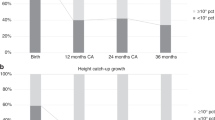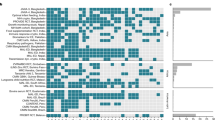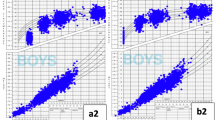Abstract
The knowledge about the long-term growth of very preterm children in relation to gestational age at birth is incomplete. Therefore, a retrospective study of longitudinal growth from birth to 7 y of age in 52 of 56 surviving children who were born at a gestational age of <29 wk between 1988 and 1991 to mothers resident in the city of Göteborg, Sweden, was performed. A majority of the children had an initial decrease in weight during the first months of life, followed by an increase, with a maximum weight gain occurring at 36–40 wk postmenstrual age. After a period of decreased weight and length velocity, a second increase in weight velocity was demonstrated from 6 mo to 2 y of corrected age. A corresponding increase in length velocity was found from 2 to 12 mo of corrected age. A later catch-up growth period was found at 4-5 y of age. At 7 y of age, all but two had reached the normal height range of the population. This long-term catch-up in height was established later in those who were born at an earlier gestational age. We conclude that all preterm infants had an initial period of poor growth, which rendered them growth retarded during the first years of life. It took approximately 4-7 y to overcome what the very preterm child lost in growth during the first months of life. However, as a group, they did reach normal height, weight, and weight for height before puberty.
Similar content being viewed by others
Log in or create a free account to read this content
Gain free access to this article, as well as selected content from this journal and more on nature.com
or
Abbreviations
- GA:
-
gestational age
- SDS:
-
SD score
REFERENCES
Arnold CC, Kramer MS, Hobbs CA, McLean FH, Usher RH 1991 Very low birthweight: a problematic cohort for epidemiological studies of very small or immature neonates. Am J Epidemiol 134: 604–613
Kitchen WH, Doyle LW, Ford GW, Callanan C 1992 Very low birth weight and growth to age 8 years. I: weight and height. Am J Dis Child 146: 40–45
Forrester TE, Wilks RJ, Bennett FI, Simeon D, Osmond C, Allen M, Chung AP, Scott P 1996 Fetal growth and cardiovascular risk factors in Jamaican schoolchildren. BMJ 312: 156–160
Rich-Edwards JW, Stampfer MJ, Manson JE, Rosner B, Hankinson SE, Colditz GA, Hennekens CH, Willet WC 1997 Birth weight and risk of cardiovascular disease in a cohort of women followed up since 1976. BMJ 315: 396–400
Eriksson JG, Forsén T, Tuomilehto J, Winter PD, Osmond C, Barker DJP 1999 Catch-up growth in childhood and death from coronary heart disease: longitudinal study. BMJ 318: 427–431
Sörensen HT, Sabroe S, Olsen J, Rothman KJ, Gillman MW, Fischer P 1997 Birth weight and cognitive function in young adult life: historical cohort study. BMJ 315: 401–403
Hård AL, Niklasson A, Svensson E, Hellström A 2000 Visual function in school-aged children born before 29 weeks of gestation: a population-based study. Dev Med Child Neurol 42: 100–105
Marsal K, Persson P-H, Larsen T, Lilja H, Selbing A, Sultan B 1996 Intrauterine growth curves based on ultrasonically estimated foetal weights. Acta Paediatr 85: 843–848
Niklasson A, Karlberg P 1999 New reference for Swedish infants size at birth. Horm Res 51 ( suppl 2): 28
Albertsson Wikland KA, Luo ZC, Niklasson A, Karlberg J 2002 Swedish population-based longitudinal reference values from birth to 18 years of age for height, weight and head circumference. Acta Paediatr 91: 739–754
Karlberg J, Albertsson-Wikland K 1995 Growth in full-term small-for-gestational age infants: from birth to final height. Pediatr Res 38: 1–7
Gill A, Yu VY, Bajuk B, Astbury J 1986 Postnatal growth in infants born before 30 weeks' gestation. Arch Dis Child 61: 549–553
Ehrencrantz RA, Younes N, Lemons JA, Fanaroff AA, Donovan EF, Wright LL, Katsikiotis V, Tyson JE, Oh W, Shankaran S, Bauer CR, Korones SB, Stoll BJ, Stevenson DK, Papile L 1999 Longitudinal growth of hospitalized very low birth weight infants. Pediatrics 104: 280–289
Ross G, Lipper EG, Auld PA 1990 Growth achievement of very low birth weight premature children at school age. J Pediatr 117: 307–309
Qvigstad E, Verloove-Vanhorick SP, Ens-Dokkum MH, Schreuder AM, Veen S, Brand R, Oostdijk W, Ruys JH 1993 Prediction of height achievement at five years of age in children born very preterm or with very low birth weight: continuation of catch-up growth after two years of age. Acta Paediatr 82: 444–448
Hirata T, Bosque E 1998 When they grow up: the growth of extremely low birth weight (>1000 gm) infants at adolescence. J Pediatr 132: 1033–1035
Karlberg JP, Albertsson-Wikland K, Kwan EY, Lam BC, Low LC 1997 The timing of early postnatal catch-up growth in normal, full-term infants born short for gestational age. Horm Res 48: 17–24
Michaelsen KM, Skow L, Badsberg JH, Jörgensen M 1991 Short-term measurement of linear growth in preterm infants: validation of a hand-held knemometer. Pediatr Res 30: 464–468
Gibson AT, Pearse RG, Wales JK 1993 Knemometry and the assessment of growth in premature babies. Arch Dis Child 69: 498–504
Hermanussen M, Seele K 1997 Mini-knemometry: an accurate technique for lower leg length measurements in early childhood. Ann Hum Biol 24: 307–313
Engström E, Wållgren K, Hellström A, Niklasson A 2003 Knee-heel length measurements in preterm infants: evaluation of a simple electronically equipped instrument. Acta Pediatr 92: 211–215
Karlberg J 1987 Modeling of human growth. Thesis. Göteborg University, Sweden
Roseboom TJ, van Der Meulen JH, Osmond C, Barker DJ, Ravelli AC, Bleker OP 2000 Plasma lipid profiles in adults after prenatal exposure to the dutch famine. Am J Clin Nutr 72: 1101–1106
Roseboom TJ, van Der Meulen JH, Osmond C, Barker DJ, Ravelli AC, Schroeder-Tanka JM, van Montfrans GA, Michels RP, Bleker OP 2000 Coronary heart disease after prenatal exposure to the dutch famine, 1944–45. Heart 84: 595–598
Ravelli AC, van Der Meulen JH, Michels RP, Osmond C, Barker DJ, Hales CN, Bleker OP 1998 Glucose tolerance in adults after prenatal exposure to famine. Lancet 351: 173–177
Barker DJP, Osmond C, Golding J, Kuh D, Wadsworth ME 1989 Growth in utero, blood pressure in childhood and adult life, and mortality from cardiovascular disease. BMJ 298: 564–567
Phipps K, Barker DJ, Hales CN, Fall CH, Osmond C, Clark PM 1993 Fetal growth and impaired glucose tolerance in men and women. Diabetologia 36: 225–228
Barker DJP 1995 Fetal origins of coronary heart disease. BMJ 311: 171–174
Lucas A, Fewtrell MS, Cole TJ 1999 Fetal origins of adult disease—the hypothesis revisited. BMJ 319: 245–249
Papile LA, Burstein J, Burstein R, Koffler H 1978 Incidence and evolution of subependymal and intraventricular hemorrhage: a study of infants with birth weights less than 1,500 gm. J Pediatr 92: 529–534
The Committee for the Classification of Retinopathy of Prematurity 1984 An international classification of retinopathy of prematurity. Arch Ophthalmol 102: 1130–1134
Acknowledgements
We are grateful to Ann-Helén Liljeström, Margareta Olsson, and Birgitta Svensson, GPGRC, and Petra Otterblad Olausson Medical birth registry for assistance with data collection.
Author information
Authors and Affiliations
Corresponding author
Additional information
This work was supported by grants from The Swedish Medical Research Council (7509, 10863, and 13515), The Knut and Alice Wallenberg Foundation, The Frimurare-Barnhusdirektionen, The Göteborg Medical Society, and Vilhelm och Martina Lundgrens Foundation.
Rights and permissions
About this article
Cite this article
Niklasson, A., Engström, E., Hård, AL. et al. Growth in Very Preterm Children: A Longitudinal Study. Pediatr Res 54, 899–905 (2003). https://doi.org/10.1203/01.PDR.0000091287.38691.EF
Received:
Accepted:
Issue date:
DOI: https://doi.org/10.1203/01.PDR.0000091287.38691.EF
This article is cited by
-
High protein intake on later outcomes in preterm children: a systematic review and meta-analysis
Pediatric Research (2024)
-
Catch-up growth of infants born to mothers with autoimmune rheumatic disorders
Pediatric Rheumatology (2022)
-
Functional principal component analysis for identifying the child growth pattern using longitudinal birth cohort data
BMC Medical Research Methodology (2022)
-
Assessment of catabolic state in infants with the use of urinary titin N-fragment
Pediatric Research (2022)
-
Growth of extremely low birth weight infants at a tertiary hospital in a middle-income country
BMC Pediatrics (2019)



